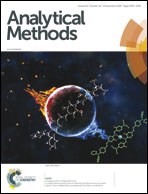A novel fluorescent probe for Hg2+ detection in a wide pH range and its application in living cell imaging†
Abstract
A novel fluorescent probe (XL-1) exhibited over 50-fold enhanced fluorescence in the presence of Hg2+ and no interference could be produced by other metal ions, anions and amino acids. The recognition mechanism was confirmed by NMR and HRMS. The most attractive point was that XL-1 could maintain a stable detection performance for Hg2+ in a wide pH range from 3.0 to 11.0, indicating that it is an effective tool for Hg2+ detection in different acid–base environments. Furthermore, the confocal fluorescence images demonstrated that XL-1 could be used for monitoring Hg2+ in living cells.



 Please wait while we load your content...
Please wait while we load your content...